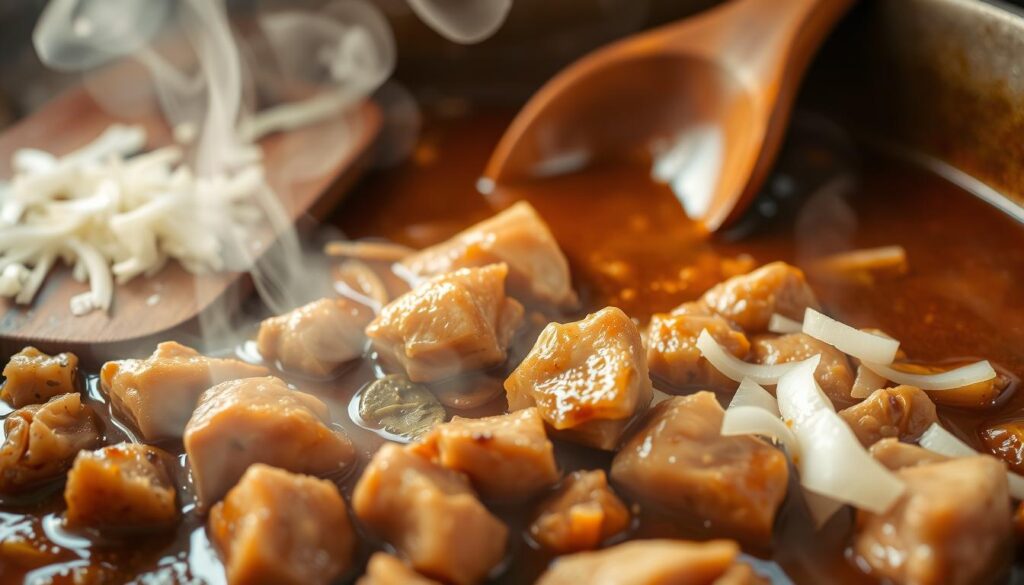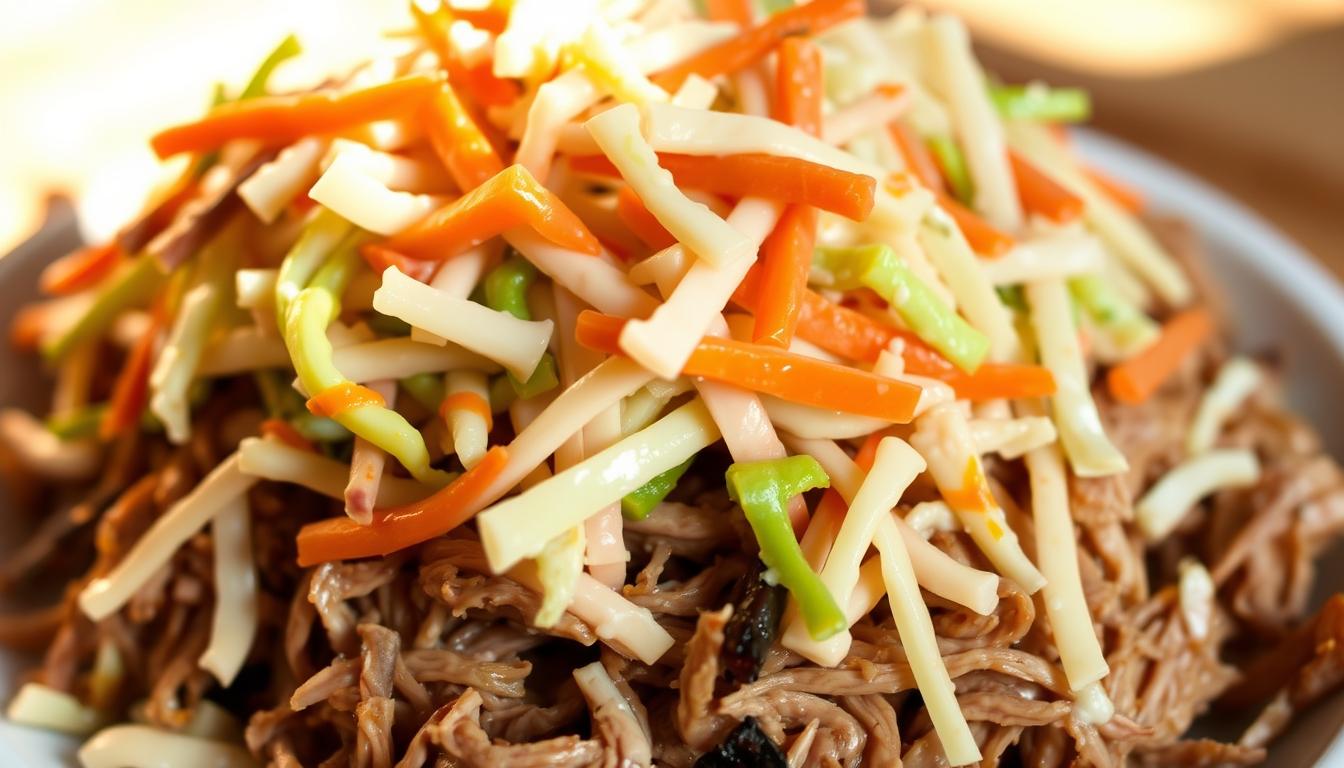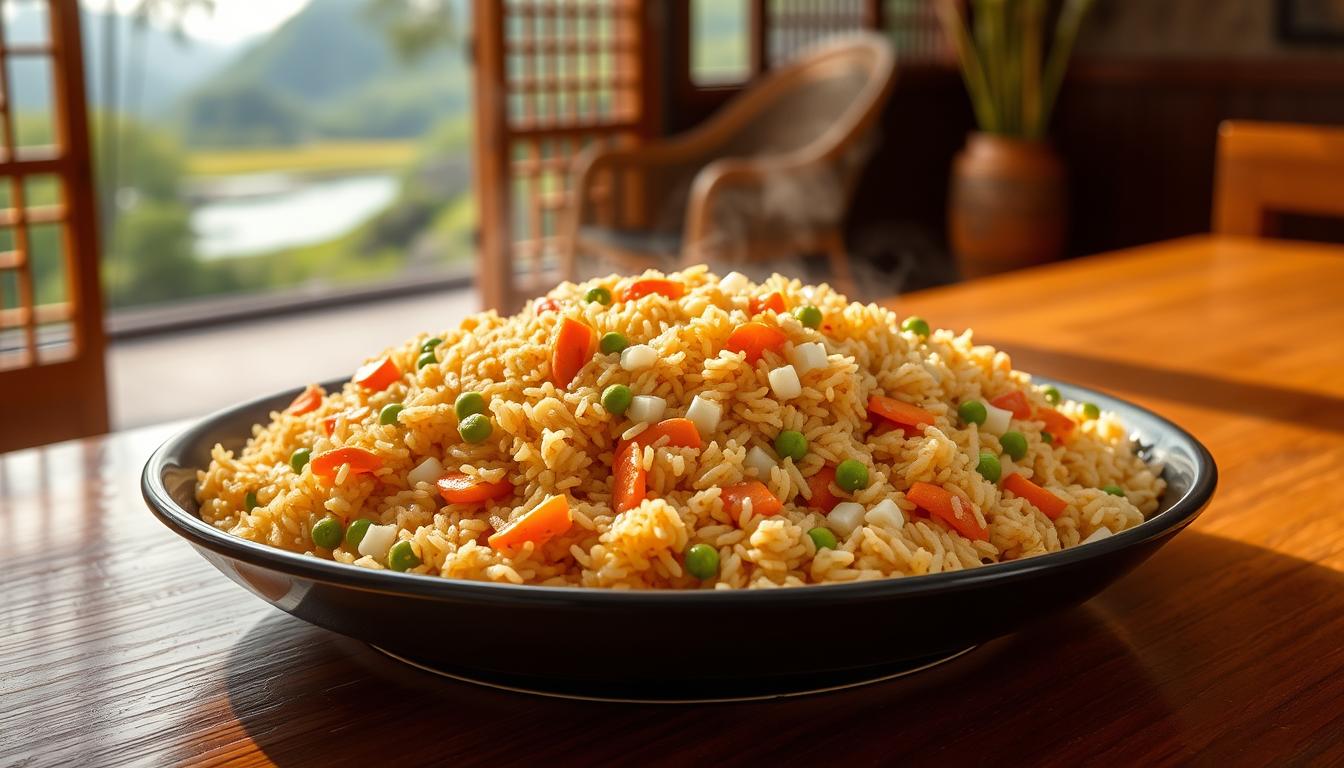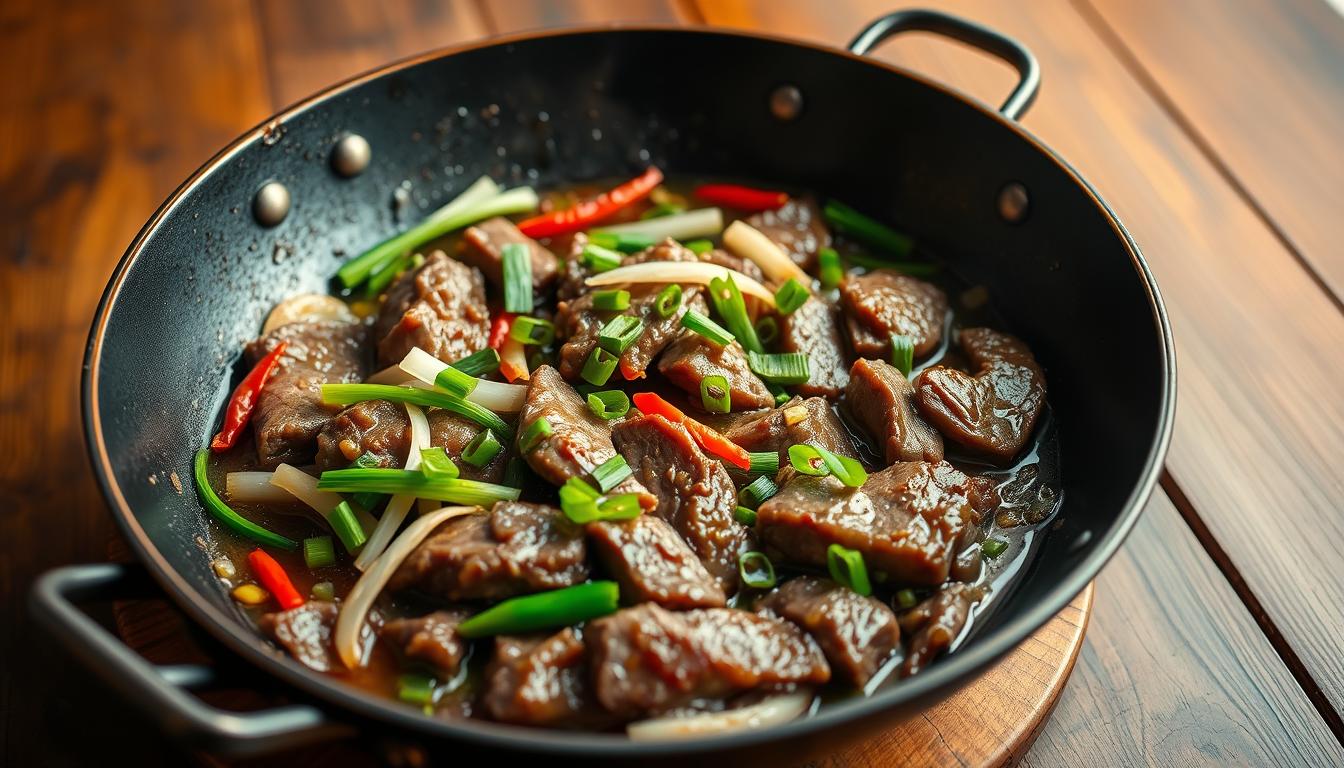Imagine stepping into a lively Filipino kitchen. The smell of pork adobo fills the air. It’s more than a meal; it’s a journey through generations and the Philippines’ rich flavors.
Pork adobo is a cultural gem that has lasted for centuries. It started as a way to preserve food, turning simple ingredients into a flavorful masterpiece.
Learning about pork adobo starts with its roots. It’s made with pork belly or shoulder, mixed with vinegar, soy sauce, and garlic. This marinade not only keeps the meat fresh but also creates a unique taste that people love all over the world.
Key Takeaways
- Pork adobo is considered a national culinary symbol of the Philippines
- The dish combines preservation techniques with exceptional flavor
- Traditional ingredients include vinegar, soy sauce, and garlic
- Pork adobo reflects centuries of cultural influences
- The recipe varies across different regions of the Philippines
1. Understanding Pork Adobo: A Culinary Overview
Pork adobo is at the heart of Filipino cuisine. It’s a dish loved by many, showing the beauty of traditional cooking. This recipe mixes flavors in a special way, turning simple ingredients into a work of art.
What is Adobo?
Adobo is more than a recipe; it’s a cooking tradition from the Philippines. It involves marinating meat in vinegar, soy sauce, garlic, and spices. This method creates a unique, tangy taste that makes pork adobo special in Asian cuisine.
Regional Variations of Adobo
Filipino cuisine is diverse, with many adobo variations. Each region adds its own twist to the classic pork adobo:
- Adobo sa Gata: Uses coconut milk for a creamy texture
- Adobong Puti: A lighter version without soy sauce
- Spicy Adobo: Adds local chili peppers for heat
Key Ingredients that Make Pork Adobo Unique
The secret to pork adobo is its balanced ingredients. A typical recipe includes:
- 2 lbs of pork belly
- 1/2 cup soy sauce
- 4 tablespoons vinegar
- 2 tablespoons minced garlic
- Whole peppercorns
- Bay leaves
The mix of these ingredients creates a complex and deeply satisfying flavor. This flavor has made pork adobo famous worldwide. Each part adds to the dish’s amazing taste, showing the richness of Filipino cooking traditions.
2. The History of Pork Adobo in Filipino Cuisine
Filipino pork adobo is a culinary gem that shows the Philippines’ rich culture. It has a long history, blending local cooking with global tastes. This has shaped Filipino food.
Origins of Adobo
The history of filipino pork adobo goes back to before the Spanish came. Indigenous people used vinegar and salt to preserve food. This method became the base of adobo.
*”Adobo represents more than just a meal – it’s a living narrative of Filipino resilience and creativity.”*
Evolution Over the Years
Pork adobo has changed a lot over time. Important moments in its evolution include:
- 10th Century: Chinese traders introduced soy sauce, changing the recipe
- 16th Century: Spanish colonization added new cooking styles and ingredients
- Modern Era: Global food trends keep inspiring new adobo recipes
Influence on Modern Filipino Cooking
Today, filipino pork adobo is more than a dish. It’s a symbol of Filipino culture. It has become famous around the world, inspiring chefs and connecting Filipinos everywhere.
Pork adobo’s rich flavors and deep history make it special. It keeps evolving while staying true to its roots. This shows the lively spirit of Filipino cooking.
3. Preparing Pork Adobo: Step-by-Step Guide
Learning to make pork adobo is all about the right techniques and ingredients. This guide will help you make a true adobo recipe. It’s a key part of Filipino cuisine.
Essential Cooking Tools
To make a tasty pork adobo, you’ll need some important kitchen tools:
- Heavy-bottomed pot or Dutch oven
- Sharp kitchen knife
- Cutting board
- Wooden spoon
- Measuring cups and spoons
Ingredients You’ll Need
A great pork recipe needs specific ingredients for its tangy flavor:
- 2 pounds pork belly, cubed
- 5 garlic cloves, peeled
- ¼ cup white vinegar
- ¼ cup regular soy sauce
- 1 tablespoon dark soy sauce
- 5 bay leaves
- 1 tablespoon whole black peppercorns
- 3 tablespoons sugar
- 3 tablespoons cooking oil
- 2 cups water
Cooking Techniques for Perfect Adobo
Making an amazing pork adobo takes careful prep and patience. Start by marinating the pork in vinegar, soy sauce, and garlic for at least 30 minutes. This lets the meat soak up rich flavors.
Here’s how to cook a perfect pork adobo:
- Heat oil in a heavy-bottomed pot
- Brown pork cubes for about 15 minutes
- Add marinade and other ingredients
- Simmer on low heat for 40-50 minutes
- Make sure pork is tender
Pro tip: Wait for the vinegar to evaporate before adding other ingredients. This prevents a too sharp taste. The slow cooking makes tough meat tender and flavorful.
4. The Secret to a Flavorful Pork Adobo
Making a great pork adobo recipe is all about the flavors. It’s about knowing how to mix ingredients in the right way. This turns simple parts into a dish that’s truly special.

Marinade Tips for Enhanced Flavor
The first step to a delicious pork adobo is a good marinade. Here are some key tips to get the best flavor:
- Use crushed garlic for maximum flavor release
- Marinate pork shoulder cut into 2-inch cubes
- Allow at least 1 hour marinating time, preferably overnight
Balancing Sweetness and Saltiness
The secret to a great adobo is finding the right balance of flavors. Use these amounts to get it just right:
| Ingredient | Quantity | Purpose |
|---|---|---|
| Soy Sauce | 1/3 cup | Saltiness |
| White Vinegar | 1/4 cup | Acidity |
| Brown Sugar | 2 tablespoons | Sweetness |
The Importance of Cooking Time
Slow cooking is key for rich flavors in your pork adobo. It makes tough meat tender and full of flavor. Aim for:
- 30 minutes of initial braising
- 2 minutes of sauce reduction
- Total cooking time around 40-60 minutes
Pro tip: Shoulder meat is the best for pork adobo. It has the right mix of meat and fat. When done right, your dish will show off the rich flavors of Filipino cooking.
5. Serving Suggestions for Pork Adobo
Discovering the perfect accompaniments can turn your pork adobo into a memorable meal. Filipino pork adobo is more than food—it’s a celebration of flavors. It connects you to rich cultural traditions.
When serving pork adobo, aim for a balanced and exciting meal. Our curated suggestions will help you impress family and friends with your Filipino cooking skills.
Traditional Accompaniments
Steamed white rice is the classic choice for pork adobo. The rice’s subtle flavor perfectly absorbs the rich adobo sauce. This creates a harmonious bite every time.
- Garlic fried rice (sinangag)
- Steamed jasmine rice
- Rice cooked directly in adobo sauce
Creative Side Dishes
Try these exciting side dish options to complement the robust flavors of Filipino pork adobo:
| Side Dish | Preparation Time | Flavor Profile |
|---|---|---|
| Sweet Potato Fries | 20 minutes | Crispy, slightly sweet |
| Gising-Gising | 25 minutes | Spicy, vegetable-rich |
| Ube Halaya | 30 minutes | Sweet, creamy |
Best Pairings for Adobo
Complete your meal with beverages that enhance the pork adobo’s complex flavors:
- San Miguel Beer – A classic Filipino lager
- Calamansi juice
- Coconut water
Remember, the key to an unforgettable pork adobo experience is balancing flavors. Enjoy the meal with loved ones.
6. Pork Adobo Variations You Need to Try
Trying different pork adobo recipes can change how you see cooking. Each one adds a new spin to the classic dish. This lets you play with flavors and methods, showing how versatile this Filipino favorite is.

Traditional pork adobo is great, but these variations will make your cooking better. They introduce you to new tastes and ways to cook.
Adobo sa Mangal: Smoky Grilled Delight
Adobo sa Mangal makes pork adobo even better by adding smoky flavor. It uses a grilling method to:
- Marinate the pork in classic adobo sauce
- Grill the meat for a charred outside
- Give every bite a smoky taste
Creamy Coconut Milk Adobo
The Bicol region’s Adobo sa Gata adds coconut milk to pork adobo. This makes the sauce creamy and rich, turning the dish into a luxurious treat.
- Makes the sauce silky
- Brings a hint of sweetness
- Makes the meat even more tender
Tropical Pineapple Adobo
The pineapple adobo recipe is sweet and tangy. Adding fresh pineapple chunks makes the dish unique. It mixes savory and tropical flavors.
- Brings natural sweetness
- Offers a bright, tangy contrast
- Makes the meat tender
These pork adobo variations keep the dish’s core but add exciting new aspects. Feel free to try them out and find your favorite!
7. Common Mistakes to Avoid When Making Pork Adobo
Making the perfect pork adobo recipe needs precision and care. Many home cooks face challenges that can ruin this beloved Filipino dish. Knowing these common mistakes helps you make an amazing adobo that truly captures Filipino flavors.
Overcooking: The Silent Flavor Killer
Pork adobo cooking time is crucial. Overcooking can make tender meat dry and tough. The key is maintaining low, slow heat to keep the meat juicy.
- Monitor cooking temperature closely
- Use a meat thermometer for precision
- Remove meat from heat when it reaches 145°F
The Crucial Marinade Step
Skipping the marinade is a big mistake in making pork adobo. Marinating lets the meat soak up vinegar, soy sauce, and spices. Experts say marinate for at least 3 hours for deep flavors.
Balancing Ingredient Proportions
Getting the right mix of ingredients is key to a great adobo. Wrong proportions can make the dish too sour or salty.
| Ingredient | Recommended Proportion | Impact on Flavor |
|---|---|---|
| Vinegar | 1/2 cup per 2 lbs meat | Provides acidity |
| Soy Sauce | 1/4 cup per 2 lbs meat | Adds umami depth |
| Garlic | 8 cloves | Enhances aromatics |
“The secret to great pork adobo lies not just in the ingredients, but in understanding their delicate balance.” – Filipino Culinary Tradition
Avoiding these common mistakes will make your pork adobo amazing. You’ll create a dish that truly honors Filipino culinary heritage.
8. Health Benefits of Pork Adobo
Pork adobo is more than just a tasty Filipino dish. It can also be a healthy part of your diet if made with care. Knowing what’s in this classic recipe helps you choose better foods.
Nutritional Value of Pork
Pork is a great protein source for your meals. A serving of pork adobo gives you important nutrients for muscle growth and health. The protein in it helps:
- Build and repair muscle tissue
- Support metabolic functions
- Provide sustained energy
Benefits of Key Ingredients
The ingredients in pork adobo do more than add flavor. Garlic and vinegar, key parts of the dish, offer big health benefits:
- Garlic: Has antimicrobial properties
- Vinegar: May improve digestion
- Helps regulate blood sugar
Making Pork Adobo Healthier
While pork tocino has more fat, you can make pork adobo healthier. Here are ways to improve its nutrition:
- Choose leaner pork cuts
- Use less salt to reduce sodium
- Add more veggies for extra nutrients
- Control how much you eat
By picking the right ingredients, you can make pork adobo a nutritious meal. It will taste great and help you reach your health goals.
9. Enjoying Pork Adobo: A Cultural Experience
Filipino pork adobo is more than just a meal. It’s a lively tradition that links families and communities. Making this dish is a way to connect with Filipino heritage and family ties.
Sharing filipino pork adobo with friends lets you dive into Filipino cuisine’s richness. Every bite shares a story of regional traditions. Different families add their own twist, like coconut milk or extra spices, making each dish unique.
Adobo, like pork mechado, shows the community spirit of Filipino cooking. It’s made in big batches for everyone to enjoy over days. It’s perfect for family gatherings and casual dinners, showing its importance in Filipino culture. By cooking and sharing this recipe, you honor a treasured tradition.
Exploring Filipino cuisine means discovering cultural history in every recipe. Pork adobo offers a taste of the warmth, creativity, and connection that define Filipino cooking. It’s a flavorful journey through heritage.
FAQ
What exactly is pork adobo?
Pork adobo is a beloved Filipino dish. It’s made with tender pork, vinegar, soy sauce, garlic, and spices. This dish is known for its tangy, savory taste and easy preparation.
Is adobo only made with pork?
No, adobo can be made with chicken, beef, or seafood too. But pork adobo is the most popular. The cooking method and ingredients are similar for all proteins.
How long does it take to cook pork adobo?
Cooking pork adobo takes 60-90 minutes. Most of this time is for slow cooking to make the meat tender. Marinating for 2-4 hours adds to the flavor.
Can I make pork adobo healthier?
Yes, you can make it healthier. Use leaner pork, reduce sodium, add veggies, and control portions. Try baking or using less oil for healthier cooking.
What are some popular adobo variations?
Variations include Adobo sa Gata (with coconut milk) and Adobong Puti (white adobo). There’s also Adobo with pineapple and Adobo sa Mangal (smoky grilled flavor). Each offers a unique twist.
What should I serve with pork adobo?
Serve it with steamed white rice or try quinoa, cauliflower rice, or fresh veggies. Pair it with light beers, white wine, or citrus drinks.
Is pork adobo difficult to make?
No, it’s easy for home cooks. Just follow the recipe, marinate well, and cook slowly. This ensures tender meat and great flavor.
What makes adobo different from other Filipino pork dishes?
Adobo stands out with its vinegar and soy sauce cooking method. This creates a tangy, savory flavor that’s unique among Filipino pork dishes.














